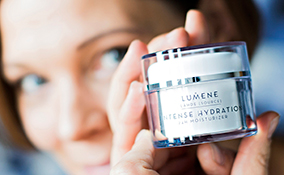The package tells the product’s story


Tubes, bottles and jars of different designs and colours pass along the conveyor belt at Lumene Oy’s packing facility in Espoo.
The products are filled, their lids closed and labels attached, and finally, they are slid into their cardboard packages. The journey of a product takes mere minutes, and watching one from one phase to the next is strangely hypnotic.
Up to 80 per cent of Lumene’s products are made at the Espoo plant: cosmetics of various forms, from liquids to make-up products, move through the plant continually.
“The packing facility works in two shifts. The contents, or the actual products, are made by the production unit downstairs,” says Lumene Oy’s Packaging Development Manager Kristina Enqvist.
Aesthetic protection for the product
“The main function of the package and its material is to protect the product,” explains Pia Ehrstedt, Lumene Oy’s Head of Procurement, about the basis of the design.
“Of course aesthetics also play an important role in cosmetic products. From the marketing perspective, the package is an essential part of the product,” Enqvist continues.
According to Enqvist, the aesthetic considerations also mean that the outer package must tell the product’s story. This is a challenge for cosmetic products:
“In addition to the marketing narrative, the package must include compulsory information to meet the legal requirements in different countries, and the space for this is very limited.”
One of the problems that package designers face is the size of the text in a variety of languages: it should be small yet legible.
“The designers need the right skills and creativity, and they have to work closely with product managers,” says Enqvist.
An important sales tool
Lumene renewed its brand and the look of its packages last autumn.
“Our brand has always been strong, but we decided to clarify and sharpen our story, the main message of which is Beauty born of light.”
The packages, product formulas, logo and our marketing communications were revamped to fit the new brand philosophy.
“We wanted to make the Lumene brand more desirable and ensure that the demand will grow even stronger.”
Visibility can be enhanced in a number of ways, but, in the end, it is the packages that sell the products. Lumene does not believe in gimmickry but relies on the power of high-quality design:
“Marketing in the digital age is, of course, different from what it used to be, but the product is still sold on the merit of its packaging,” Enqvist points out.
Enqvist explains that the size, colour and design of the package are what count in the highly competitive cosmetics industry.
“We sometimes use free-standing display units and banners in our campaigns in stores. At other times our products’ packages must stand out among the competitors on the shelf.”
Some fantastically imaginative means for differentiation have been invented over the past ten years. Advances in digital printing, in particular, allow for the design of unique labels and prints.
“You can have a photo printed on the label or use a variety of metal coatings or effect paints. We can make two identical jars look completely different,” Ehrstedt explains.
Recycling all the parts
Several materials, including plastic, cardboard and glass, are used in the cosmetics packaging.
“It’s very interesting for the designer to be able to use several materials in one product. The printing, however, must look exactly the same on every layer.”
For example, the colour of the glass jar for a face cream must be replicated on its cardboard box. If the package is transparent, the colour is also affected by the colour of the cream in the jar.
Another challenge for the package designer is that there are different suppliers for every component of the product.
“The colours must be matched across the different suppliers, and this takes time,” says Enqvist.
As one product can be made of as many as ten different materials, the recycling perspective needs to be taken into account. According to Enqvist, packaging innovations are not necessarily noticeable to a consumer as they may relate to the use of recycled materials or the recyclability of the elements.
“Our aim is to use packaging solutions that are as easy to recycle as possible using the existing facilities. We also follow the packaging industry’s advances in the sectors where the environmental impacts are discussed.”
Close collaboration with subcontractors and suppliers of materials is essential:
“It’s our job to know what each supplier can offer and what solutions will be available. We test the functionality of new materials and components to assess if they are suitable for our needs and if they fit with our story.”
31.5.2017
Text Susanna Haanpää
Images Pekka Holmström